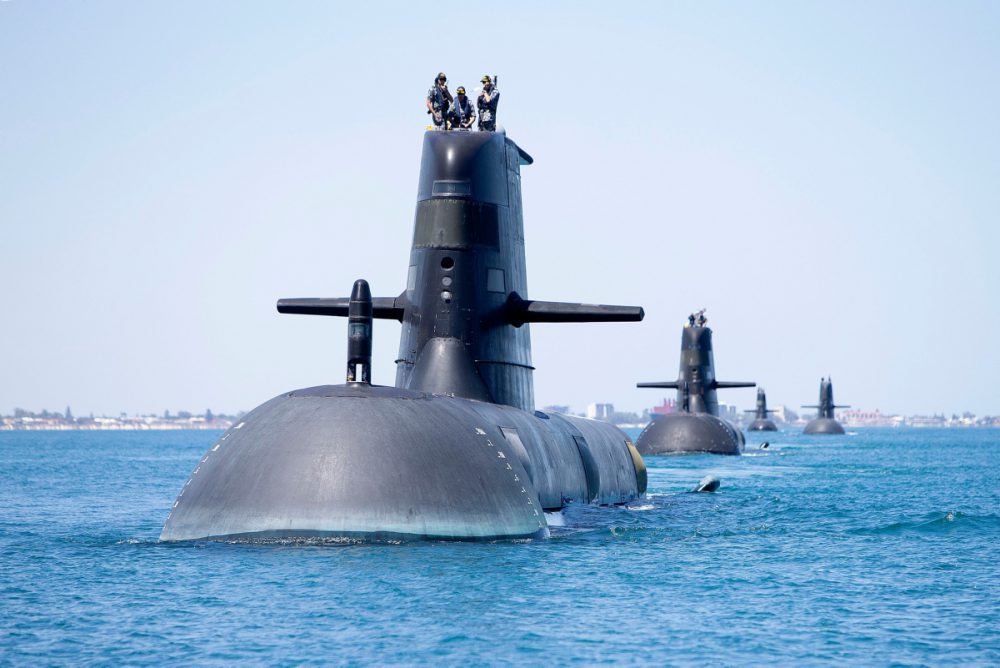
Hugh White’s latest book has stimulated an important debate on the defence capabilities needed to preserve Australia as a sovereign state.
In the recent posts on this subject on The Strategist, there’s been recognition of the insight and erudition of White’s analysis, but much criticism of particular points he makes.
But there’s one more perspective that I haven’t yet seen fully covered. White, while dismissive of future fighting roles for surface warships, suggests a vastly enlarged fleet of submarines, possibly as many as 24 or even 36.
What does he see as the future role for Australia’s submarines that suggests we might need so many of them? The Strategist’s defence editor, Brendan Nicholson, summarised White’s view on that need:
While submarines are considered to be the most effective weapon against other submarines, White argues that shouldn’t be their function. The main targets of a new and much larger fleet of submarines will be an adversary’s surface ships approaching through the archipelago to Australia’s north. They would not then need the range to loiter off China’s submarine bases.
Six Oberon-class submarines were in RAN service from 1969 to 2000 and the first of our six Collins-class vessel was commissioned in 1996. As far as I’m aware, none of these 12 submarines has ever fired a weapon in anger. Does that mean they’ve been a waste of money? Certainly not.
Our subs have been an invaluable resource in patrolling waters around and to the north of Australia, gathering vital information, and conducting surveillance and reconnaissance (ISR) over the past 50 years.
But technology is changing, and manned submarines are no longer as important for the ISR role. Small unmanned surface vessels (USVs) like Boeing’s Liquid Robotics Wave Glider and Ocius’s Bluebottle are perfectly capable of transiting to, and then keeping watch for months at a time over, submarine and surface ship routes from our potential adversaries’ bases. All the while, they will be feeding back live or stored video to their controllers, sometimes based thousands of kilometres away in Australia.
Large unmanned underwater vessels (UUVs) like Boeing’s Echo Voyager are capable of being a ‘mothership’ to fleets of smaller UUVs which can be used for conducting underwater ISR, detecting and possibly neutralising minefields, and, if required, opposing submarines and mounting a kinetic attack against an adversary’s surface warships.
A large fleet of Australian submarines doesn’t make sense in light of the potential employment of USVs and swarms of UUVs utilising artificial intelligence for many of submarine’s classic roles. Also expect that any potential adversary will be adopting similar technologies in the maritime domain.
The attractions of USVs and UUVs include removing humans from harm’s way in lengthy and dangerous situations, relatively low cost, excellent ISR, and potential deniability or self-destruction if they are captured.
There’s also the problem of crewing the number of vessels envisaged by White. The navy has classified as secret the numbers of submarine commanders and crew currently in service, claiming that revealing the actual figures would provide vital information to the intelligence services of potential adversaries.
But it doesn’t take too much brain power to put a lower limit on these numbers. About 10 years ago crew numbers for the Collins class were raised from 42 to 58, including the commander. Assume two crews are required to provide rotations for the operational vessels, and that five Collins-class submarines are available for operations with the sixth undergoing full-cycle docking. Add a 20% loading for personnel undergoing shore training, on leave or otherwise unavailable.
That suggests a minimum of 12 submarine commanders and just under 700 other personnel in the submarine force.
White’s recommended 24-submarine fleet would boost numbers to around 50 submarine commanders and 2,800 other crew. His 36-vessel fleet would need 75 commanders and around 4,200 other crew.
Rear Admiral Rowan Moffitt’s 2008 review of the sustainability of our submarine workforce highlighted that the navy has long experienced problems finding enough crew for its six-strong submarine fleet. Since that report, many changes have been made to improve recruitment and retention, but much larger numbers still seem unattainable.
I have had the good fortune to spend time with two ex-RAN officers who successfully graduated from the very tough Perisher course and went on to become RAN submarine commanders. Both are now retired from that role and are working in the defence industry. These types of RAN officers are a rare breed and it is a significant challenge to qualify sufficient candidates through the Perisher course. Half of those taking the course routinely fail, and it’s mandated that they never go to sea in submarines again.
Surely the answer is to upgrade some or all of our Collins-class submarines, in time replacing them with up to six Shortfin Barracudas, while putting a lot more effort into building fleets of USVs and UUVs. That would not only provide sufficient manned submarines for their specialist roles, but also greatly improve persistent maritime ISR and offer potent attack and self-defence capabilities.

